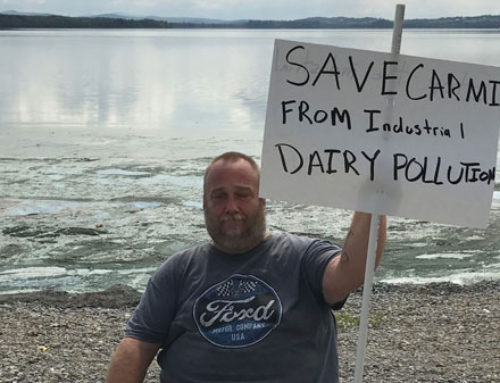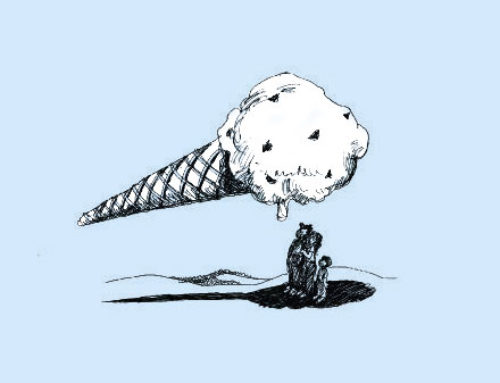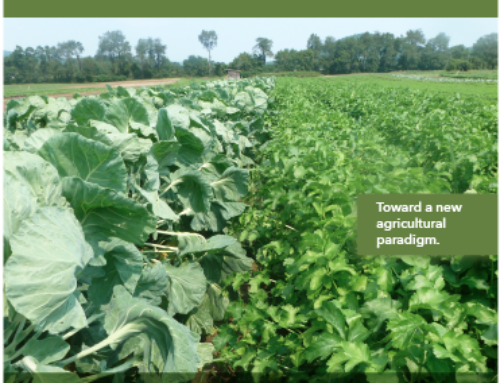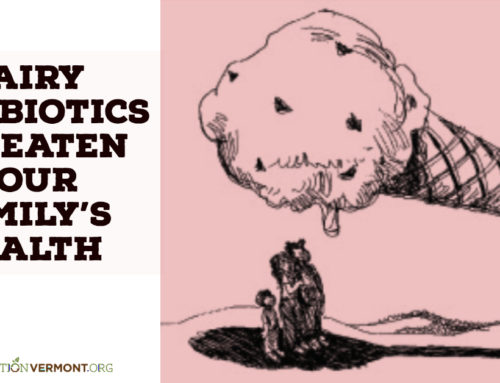Also published in the VTDigger
By Will Allen and Michael Colby
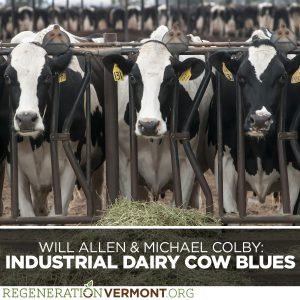 It’s no secret that the conventional dairy industry is in a deep, downward spiral, decades in the making. This is largely the result of a commodity-based pricing scheme that was designed to do exactly what it’s doing: keep prices paid to farmers low and focus on quantity over quality. The negative impacts have been widely documented, everything from farmer attrition to ecological devastation. But, when the story of industrial dairying is told, rarely are the cows given much more than a mention. And it’s probably for the better, because the story of the industrial dairy cow isn’t pretty.
It’s no secret that the conventional dairy industry is in a deep, downward spiral, decades in the making. This is largely the result of a commodity-based pricing scheme that was designed to do exactly what it’s doing: keep prices paid to farmers low and focus on quantity over quality. The negative impacts have been widely documented, everything from farmer attrition to ecological devastation. But, when the story of industrial dairying is told, rarely are the cows given much more than a mention. And it’s probably for the better, because the story of the industrial dairy cow isn’t pretty.
It all begins with dairy farm economics. The more milk produced, the bigger the glut and the lower the prices. But the lower the prices, the more milk the farmer needs to produce to try and make money. And around and around it goes, with the dairy cow taking the brunt of the push to produce more and more milk. They are, after all, doing the producing.
Currently, the price of milk at the farm is so low and so devalued that it costs the farmer more to produce it than they can sell it for. Increasingly, it’s not even worth the cost of shipping it. This year more than 40 million pounds of milk were dumped by October, shattering last year’s record dump in just nine months.
With a near-complete fixation on maximizing production, the cow has been pushed to its physical limits and beyond. The average amount of milk given per year by a dairy cow rose from about 7,000 pounds in 1970 to more than 22,000 pounds in 2012, a 313 percent increase in production – per cow. It’s been accomplished with all kinds of corporate-driven methods, from hormones and antibiotics, to stunning advancements and increases in feed, and to 24-hour confinement and increased number of milkings per day.
The industrial dairy cow has suffered greatly from this dramatically increased production. Dairy cow health is becoming a major issue for the industry, giving rise to extra costs associated with replacing the burned out cows and concerns about meat containing residues of the increased medications being used. A recent Cornell University study found that mortality rates in U.S. dairy herds was over 10 percent a year. That means one out of every 10 cows in a herd is prematurely dying every year. In 2002, the dairy mortality rate was 3.8 percent. Something’s seriously wrong in the dairy barn.
The average life expectancy of a dairy cow, when allowed to live as they are genetically wired — on grass and fresh air — is about 20 years. Today, most industrial dairy cows are processed into hamburger before they get to the age of 6, spent up and burnt out from the unfathomable amount of milk production, only surviving for an average of 2.4 lactations.
Again, it’s all by design. The feed programs outlined by the agrichemical corporations have been geared toward one thing: milk production. And the quickest way to do that is to gorge the cow with a rich and continuous diet. It works, as today’s super-producing cows are being fed nearly 130 pounds of feed a day, more than double what they used to eat a few decades ago.
Animal nutritionists working with confined-animal herds refer to the industrial dairy cow as a “nutrient highway,” a cold but realistic picture of the speed and quantity of the feed blends and nutrients “traveling” through a dairy cow daily. The problem is that this nutrient loading is all aimed squarely at milk production, to the detriment of the rest of the cow’s health. In the end, the dairy cow can’t keep up, succumbing to a whole host of health issues earlier and earlier in her life, and ultimately leading to an early death, either from a chronic health issue and/or general burnout that results in an unceremonious exit to the beef yards, where all non-organic dairy cows eventually meet their end in the U.S.
“Dairy cattle death losses are an extremely important problem,” writes Dr. Franklyn Garry, DVM, a professor at Colorado State University’s College of Veterinary Medicine. “Not only are these losses an economic disaster, they also represent very substantial problems with animal well-being.”
In a paper published by the USDA’s Extension Service, “Adult Dairy Cow Mortality,” Garry documents the disturbing trends in dairy cow mortality rates, pointing directly at the causes: a focus on production, not animal health and well-being.
Garry is not alone in his conclusion: “There is a real need for the dairy industry and dairy veterinarians to reevaluate dairy management systems with a focus on optimum animal health.”
At a recent conference of the Western Dairy Seminar, Garry took issue with those in the industry who thought it was just a “genetics issue,” with talk of a need to “build a better cow” to withstand the increased production.
“This is not a genetics problem, this is a management problem,” Garry said. “Death losses reveal significant health and welfare issues. It is manageable and we can do a lot better.” And Garry concluded with what is on most people’s minds after peeking behind the curtain of industrial dairying: “It is tragic that people haven’t paid attention to this.”
A look at the dairy cow mortality rates and causes makes it easy to understand Garry’s alarm. According to the USDA’s National Animal Health Monitoring System (NAHMS), dairy cows are dying prematurely from painful and preventable causes like udder infections (mastitis), respiratory problems, hoof infections, leg injuries and diarrhea, all directly attributable to the conditions geared toward maximizing milk production at the expense of the cow’s health.
Residues and resistant bacteria that are introduced to the meat supply as the result of the use and misuse of these powerful antibiotics are creating serious human health concerns.
The NAHMS dairy cow mortality data even includes a category for death that is attributable to “severe depression,” which, according to the published data, accounts for 1 percent of premature dairy cow deaths annually. One has to wonder what the scene is like at those barns when the farmer or veterinarian makes that diagnosis.
Dairy Meat & Antibiotics
Interestingly, much of the spotlight being put on the animal welfare issues in industrial dairying is coming from the beef cattle industry, which is increasingly worried about dairy-derived meat sullying its reputation. While the great majority of U.S. cows are beef cows, a very large percentage of the beef supply comes from dairy cows. Even though dairy’s percentage of animals is low, used-up or redirected dairy animals accounted for an annual average of 47 percent of total cow slaughter for the last several years. In 2015, dairy cow slaughter actually reached a record level, accounting for 57 percent of the total meat supply.
The nature and methods of dairy production means that basic herd dynamics are very different for dairy compared to beef. Dairy cows are culled more quickly so dairy herd turnover happens much faster. An average of 30 percent of the dairy cow inventory is slaughtered each year compared to less than 10 percent of beef cows, according to USDA data.
What worries the cattle industry most is the presence of residues in the dairy-derived beef. The Cattle Site, an industry-based website, recently summarized the dairy-meat challenges as follows: “animal health, product residues, and thin, non-ambulatory cows in auction markets and on trucks and trailers.”
When these diseased and well-medicated dairy cows get put into those “trucks and trailers” heading for slaughter, the risk of adulterated meat reaching the marketplace skyrockets. These pharmaceutical residues – some legal, but many not — are the great bogeyman for the meat industry, a certain no-no for an industry already trying to dodge public health and public relations issues.
Again, it all comes back to dairy economics: When dairy farmers are losing money, the temptation to bend and break the rules governing animal medications becomes greater. Certain drugs, like Ceftiofur, a powerful antibiotic, are used by dairy farmers to keep cows upright and living long enough to get them to the slaughterhouse.
“We’re talking about our livelihood, our money,” was how one dairy farmer summed up his situation in a special report on Ceftiofur by Reuters in 2014 (“Powerful antibiotic for cows often misused by farmers”). “We’re trying to save the cow and if we can’t save the cow, we’re trying to salvage it. In other words, send her to the stockyard and get something out of it. So there’s a temptation to fudge on it.”
The problem is that the residues and resistant bacteria that are introduced to the meat supply as the result of the use and misuse of these powerful antibiotics are creating serious human health concerns. The U.S. Food & Drug Administration (FDA), the agency in charge of approving and regulating on-farm drug use, classifies Ceftiofur as a “high public health risk,” primarily because of its close relation to an important class of human antibiotics used to treat pneumonia, meningitis and a host of other common infections, particularly in children. When Ceftiofur residues, along with the resistant bacteria that they give rise to, are consumed in the meat and dairy supply, they can nullify the effectiveness of antibiotics used to treat human illnesses.
While the FDA doesn’t mince words when sounding the alarm about the dangers of antibiotic residues in the meat and dairy supply, it goes fairly limp when it comes to enforcement – mostly talk, and very little action. This is partially the result of the confusing and contradictory web of agencies involved with regulation, monitoring and enforcement. The FDA approves and regulates the use of the on-farm drugs, while they also oversee residue testing for milk. But the U.S. Department of Agriculture’s Food Safety & Inspection Service monitors for meat residues, while both rely on the U.S. Department of Justice for enforcement.
The FDA, for example, regularly issues “warning letters” to dairy farms found to be violating its residue protocols but it very rarely takes significant action against those same dairy farms. Some farms, for example, can be on and off the list of residue violators for years, if not decades, without ever being shut down. This fumbling of enforcement led the Government Accountability Office to declare in its 2010 report that the FDA “is not accomplishing its mission of monitoring the food supply for harmful residues.”
The FDA and USDA may have rules for treating the increasingly ill cows and cattle, particularly when it comes to the residues that may be in the meat and milk. But those rules are being broken. When farmers are being crushed economically, cutting corners on waiting periods or using unapproved drugs are the most common reasons for the pharmaceutical residues remaining in the food supply. And, since almost all the violations are coming from the dairy-derived meat, it’s the cattle industry – ironically – that is putting the heat on its dairy brethren to clean up their act. That’s how bad it’s gotten.
But it doesn’t have to be this way. Overproduction is the problem, driven by a commodity-based pricing system that is obscenely rigged against the dairy farmer.
Organic and regenerative dairying immediately addresses all of the concerns of the commodity fiasco — economics, animal welfare, water quality — all within a changed mindset, from quantity to quality. It’s not perfect, but it’s the obvious step forward.
The dairy cows on organic farms, for example, are required to have access to pasture. Consequently, organic cows live longer, having more than double the lactations. Organic dairies don’t take the kinds of risks with regards to pushing production at the expense of cow health. The goal is a healthy cow, not a medicated cow.
One thing is certain, the industrial dairy cow and the commodity-based dairy farmer need relief. The downward spiral of both – in terms of health and economics – is serving no one but the giant dairy processors and agribusiness monopolies profiting from the exploitation. Given the current political and regulatory climate, it’s the marketplace that will dictate the change, driven by an increasing public awareness that safe, healthy food cannot come from unhealthy animals and farms teetering on the brink of bankruptcy.
